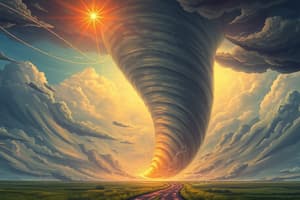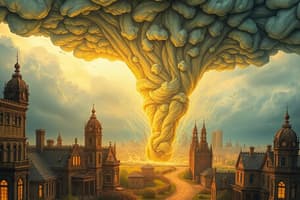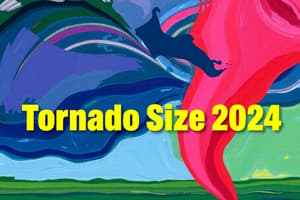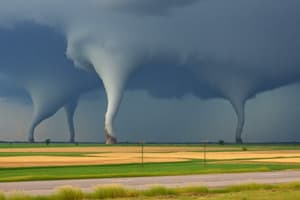Podcast
Questions and Answers
Why is it challenging for meteorologists to accurately predict tornadoes?
Why is it challenging for meteorologists to accurately predict tornadoes?
- Tornadoes are not influenced by atmospheric conditions.
- The rapid formation and short lifespan of tornadoes make them difficult to forecast. (correct)
- There is insufficient data collected on tornadoes.
- Tornadoes typically occur in remote areas with limited radar coverage.
How do meteorologists use radar technology to detect potential tornadoes?
How do meteorologists use radar technology to detect potential tornadoes?
- By analyzing changes in barometric pressure during severe weather events.
- By tracking cloud formations associated with cold fronts.
- By measuring the air temperature and humidity near thunderstorms.
- By identifying distinctive hook echoes indicative of rotation within a thunderstorm. (correct)
What role do storm chasers play in understanding tornadoes?
What role do storm chasers play in understanding tornadoes?
- They provide real-time weather reports to local news stations.
- They help evacuate populated centers in the path of the storm.
- They use specialized equipment to measure factors involved in tornado formation. (correct)
- They assist in repairing infrastructure damaged by tornadoes.
How is the intensity of a tornado determined after it has occurred?
How is the intensity of a tornado determined after it has occurred?
How does the Enhanced Fujita Scale categorize tornadoes?
How does the Enhanced Fujita Scale categorize tornadoes?
Which atmospheric condition, when combined with a supercell thunderstorm, is MOST likely to contribute to tornado formation?
Which atmospheric condition, when combined with a supercell thunderstorm, is MOST likely to contribute to tornado formation?
Why are the Great Plains and Florida particularly prone to tornadoes?
Why are the Great Plains and Florida particularly prone to tornadoes?
Why is it important for a funnel cloud to make contact with both the ground and the source cloud for it to be classified as a tornado?
Why is it important for a funnel cloud to make contact with both the ground and the source cloud for it to be classified as a tornado?
If a meteorologist detects a hook echo on Doppler radar, what is the MOST appropriate immediate action?
If a meteorologist detects a hook echo on Doppler radar, what is the MOST appropriate immediate action?
What is the approximate probability of a supercell thunderstorm forming from a regular thunderstorm, and what is the probability of a supercell producing a tornado?
What is the approximate probability of a supercell thunderstorm forming from a regular thunderstorm, and what is the probability of a supercell producing a tornado?
Flashcards
Tornado
Tornado
A column of violently rotating air formed during thunderstorms, with winds up to 250 mph.
Tornado Alley
Tornado Alley
A region in the U.S. prone to tornadoes, including states like South Dakota, Nebraska, Kansas, Oklahoma, northern Texas, and eastern Colorado.
Supercell
Supercell
A large thunderstorm with rotating winds.
Updraft
Updraft
Signup and view all the flashcards
Hook Echo
Hook Echo
Signup and view all the flashcards
Enhanced Fujita Scale
Enhanced Fujita Scale
Signup and view all the flashcards
Environmental Impact of Tornadoes
Environmental Impact of Tornadoes
Signup and view all the flashcards
Tornado Detection: Hook Echoes
Tornado Detection: Hook Echoes
Signup and view all the flashcards
Tornado Size and Intensity
Tornado Size and Intensity
Signup and view all the flashcards
Study Notes
- Each year, the U.S. experiences over 1,200 tornadoes.
- A tornado is a violently rotating column of air formed during thunderstorms, with winds up to 250 mph.
- The word "tornado" comes from the Spanish word "tornar," meaning "to turn."
- Tornadoes are also known as twisters, cyclones, or funnel clouds.
- They are most common in southern Canada and "Tornado Alley" in the U.S.
- Tornado Alley includes: South Dakota, Nebraska, Kansas, Oklahoma, northern Texas, and eastern Colorado.
- The Great Plains and Florida are prone to tornadoes due to frequent thunderstorms.
Formation
- Tornadoes typically form in late spring and summer.
- This relates to conditions ideal for supercell formation and updrafts of hot air.
- A supercell is a large thunderstorm with rotating winds, forming in approximately 1 out of 1,000 storms.
- When a supercell forms, it produces a tornado about 20% of the time.
- Vertical wind shear during severe thunderstorms and supercell formation creates a horizontally rotating air column.
- Updrafts lift this column, causing it to narrow and spin faster, forming a funnel cloud.
- A funnel cloud becomes a tornado only when it touches both the ground and the source cloud.
- Doppler radar detects hook echoes indicative of a supercell, providing about 10 minutes of warning.
- A hook echo is a bend in the radar signal for a thunderstorm.
- The rapid formation and movement of tornadoes makes it difficult to accurately predict their development.
Effects
- Tornadoes can be over 660 feet wide and travel less than six miles.
- Tornadoes cause an estimated $400 million in damage annually.
- Around 70 people die each year due to tornadoes.
- Tornadoes damage the environment by destroying forests and habitats.
- Wind-damaged forests are more susceptible to non-native plant species.
Categorization
- Meteorologists use Doppler radar and computer modeling to predict tornadic activity.
- Hook echoes indicate areas of rotation within a thunderstorm.
- Stormchasers use equipment and weather balloons to measure tornado formation factors.
- The National Weather Service assesses damage to determine wind speed and path.
- Tornadoes are rated using the Enhanced Fujita Scale, developed by Ted Fujita.
- The Enhanced Fujita Scale evaluates damage to buildings and trees against 28 damage indicators.
- Tornado size and path length are positively correlated with its destruction level.
Enhanced Fujita (EF) Scale
- Before 2007, the Fujita-Pearson (FPP) scale was used, based on damage types.
- The EF Scale, introduced in 2007, incorporates damage indicators and degrees of damage.
- The EF Scale reflects the wind speeds associated with a tornado.
- EF0: 65-85 mph, broken tree branches, some shingles blown from roofs
- EF1: 86-110 mph, loss of exterior doors, many shingles lost
- EF2: 111-135 mph, roofs torn off, mobile homes destroyed
- EF3: 136-165 mph, severe damage to large buildings; trains and cars overturned
- EF4: 166-199 mph, whole houses leveled
- EF5: 200-230 mph, houses swept away
Studying That Suits You
Use AI to generate personalized quizzes and flashcards to suit your learning preferences.





